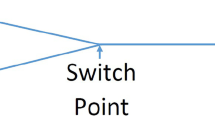Abstract
In complex logistic systems, such as transportation systems, dealing with personnel scheduling is a non-trivial task. Duties have to be created and assigned to workers in a way to optimize a certain objective function. In this paper, in particular, we consider the case of scheduling train drivers on a railway subnetwork. Train driver scheduling involves the construction of feasible duties from a set of trips to be carried out by a number of train drivers. Each duty consists of a sequence of trips to be carried out by a single train driver on a single day. The duties should be such that: each trip is covered by at least one duty, each duty satisfies feasibility constraints, additional constraints involving the complete schedule are satisfied, one or several objectives are met. In this paper we focus on minimizing the number of duties and on maximizing the robustness of the obtained schedule for outside disruptions. We present an implicit column generation solution approach. We describe a heuristic procedure to find an initial feasible solution together with a heuristic branch-and-price algorithm based on a dynamic programming algorithm for the pricing-out of columns. We tested our approach on the timetable of the Intercity train series 500, 700, 1600 and 1700 of NS Reizigers, the largest Dutch operator of passengers trains.
Similar content being viewed by others
References
Balas E., Carrera M.C. (1990). A dynamic subgradient-based branch-and-bound procedure for set covering. Operations Research, 44: 25–42
Balas E., Ho A. (1980). Set covering algorithms using cutting planes, heuristics and subgradient optimization: A computational study. Mathematical Programming Study, 12: 37–60
Barnhart C., Johnson E.L., Nemhauser G.L., Savelsbergh M.W.P., Vance P.H. (1998). Branch–and–Price: Column generation for solving huge integer programs. Operations Research, 46: 316–329
Beasley J.E. (1990). A Lagrangian heuristic for set covering problems. Naval Research Logistics, 31:151–164
Caprara, A., Fischetti, M., Guida, P. L., Toth, P., & Vigo, D. (1997). Solution of large scale railway crew planning problems: The Italian experience. Proceedings of the 7th International Workshop on Computer Aided Scheduling of Public Transport, MIT.
Caprara A., Fischetti M., Toth P., Vigo D., Guida P.L. (1997). Algorithms for railway crew management. Mathematical Programming, 79, 125–141
Caprara A., Fischetti M., Toth P. (1999). A heuristic method for the set covering problem. Operations Research, 47, 730–743
Desrosiers, J., Dumas, Y., Solomon, M. M., & Soumis, F. (1995). Time constrained routing and scheduling. In M.O. Ball et al. (Ed.), Handbooks in OR & MS (Vol. 8, pp. 35–139). Elsevier Science.
Fisher M.L., Kedia P. (1990). Optimal solutions for set covering/partitioning problems using dual heuristics. Management Science, 36, 674–688
Freling, R. (1997). Models and techniques for integrating vehicle and crew scheduling. Ph.D. Thesis, Erasmus University Rotterdam.
Hoffmann K.L., Padberg M.W. (1993). Solving airline crew scheduling problems by branch-and-cut. Management Science, 39, 657–682
Ryan D.M., Foster B.A. (1981) An integer programming approach to scheduling. In: Wren A. (eds). Computer scheduling of public transport urban passenger vehicle and crew scheduling. Amsterdam, North Holland, pp. 269-280
Savelsbergh M.W.P. (1997). A Branch-and-Price algorithm for the generalized assignment problem. Operations Research, 45, 831–841
Vance, P. H. (1993). Crew scheduling, cutting stock, and column generation: Solving huge integer programs. Ph.D. Thesis, Georgia Institute of Technology.
Vance, P. H., Atamturk, A., Barnhart, C., Gelman, E., Jonhson, E. L., Krishna, A., Mahidhara, D.,Nemhauser, G. L., & Rebello, R. (1997). A heuristic Branch-and-Price approach for the airline crew pairing problem. preprint.
Vance P.H., Barnhart C., Jonhson E.L., Nemhauser G.L. (1997). Airline crew Scheduling: a new formulation and decomposition algorithm. Operations Research, 45, 188–200
Wedelin D. (1995). An algorithm for large scale 0-1 integer programming with application to airline crew scheduling. Annals of Operations Research, 57, 283–301
Wren, A., & Fares Gualda, N.D. (1997). Integrated scheduling of buses and drivers. Proceedings of the 7th International Workshop on Computer Aided Scheduling of Public Transport, MIT.
Author information
Authors and Affiliations
Corresponding author
Rights and permissions
About this article
Cite this article
Alfieri, A., Kroon, L. & van de Velde, S. Personnel scheduling in a complex logistic system: a railway application case. J Intell Manuf 18, 223–232 (2007). https://doi.org/10.1007/s10845-007-0017-9
Received:
Accepted:
Published:
Issue Date:
DOI: https://doi.org/10.1007/s10845-007-0017-9




